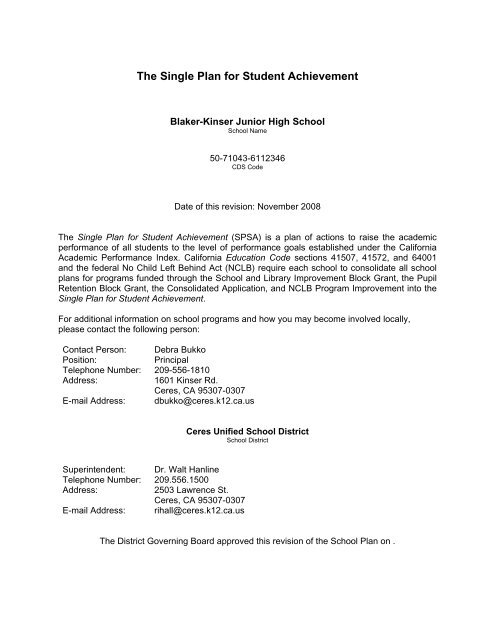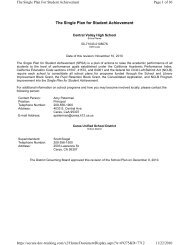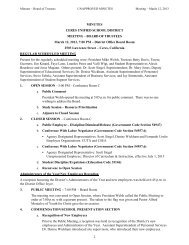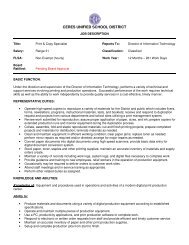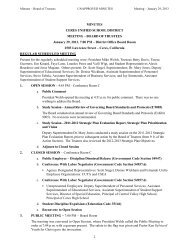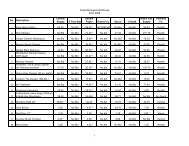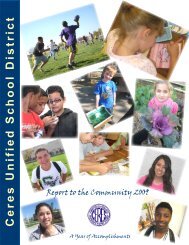SPSA - Ceres Unified School District
SPSA - Ceres Unified School District
SPSA - Ceres Unified School District
You also want an ePaper? Increase the reach of your titles
YUMPU automatically turns print PDFs into web optimized ePapers that Google loves.
The Single Plan for Student AchievementBlaker-Kinser Junior High <strong>School</strong><strong>School</strong> Name50-71043-6112346CDS CodeDate of this revision: November 2008The Single Plan for Student Achievement (<strong>SPSA</strong>) is a plan of actions to raise the academicperformance of all students to the level of performance goals established under the CaliforniaAcademic Performance Index. California Education Code sections 41507, 41572, and 64001and the federal No Child Left Behind Act (NCLB) require each school to consolidate all schoolplans for programs funded through the <strong>School</strong> and Library Improvement Block Grant, the PupilRetention Block Grant, the Consolidated Application, and NCLB Program Improvement into theSingle Plan for Student Achievement.For additional information on school programs and how you may become involved locally,please contact the following person:Contact Person: Debra BukkoPosition:PrincipalTelephone Number: 209-556-1810Address:1601 Kinser Rd.<strong>Ceres</strong>, CA 95307-0307E-mail Address: dbukko@ceres.k12.ca.us<strong>Ceres</strong> <strong>Unified</strong> <strong>School</strong> <strong>District</strong><strong>School</strong> <strong>District</strong>Superintendent: Dr. Walt HanlineTelephone Number: 209.556.1500Address:2503 Lawrence St.<strong>Ceres</strong>, CA 95307-0307E-mail Address: rihall@ceres.k12.ca.usThe <strong>District</strong> Governing Board approved this revision of the <strong>School</strong> Plan on .
II. <strong>School</strong> Vision and MissionBlaker-Kinser Junior High is a school in which all students are actively engaged in the mastery ofacademic and social skills needed for success in school and in life. Families, students and Blaker-Kinserstaff work together to provide enriching and relevant experiences so all students can become confidentand self-directed individuals.
III. <strong>School</strong> ProfileBlaker-Kinser Junior High is located in the community of <strong>Ceres</strong> in the central San Joaquin Valley. Theschool has an enrollment of 881 7th and 8th grade students, with an average of 96.13% daily actualattendance. The ethnic composition of the student population is 69% Hispanic, 19% White, not ofHispanic origin, 3% African American, 4% Asian, 2% Native American and 3% Other. English learnerscomprise 29% of our student population and 81% of the students qualify for the National <strong>School</strong> LunchProgram.The original school campus was built in 1994 (Phase I) and the buildings have been well maintained.Phase II was completed in 1998 with the addition of six classrooms, a music building, art building,technology building, home economics building and gymnasium. Construction on six additional classroomswas completed in the late fall of 2006. The school is nicely landscaped and encompasses 23 acres. Thegrounds include pickle ball courts, ¼ mile track, football field, soccer fields, basketball courts and twosoftball diamonds.The Blaker-Kinser staff includes 38 certificated teachers, a principal, an assistant principal and a learningdirector. In 2008-2009, 36 of the 38 teachers meet the rigorous NCLB criteria to be highly qualified in theirsubject area. The 2 teachers who have not yet met NCLB status are working on certification in theirindividual subject areas. Specialized programs include music, art, technology, as well as five specialeducation teachers. Support staff include one part time nurse, one part time health clerk, one part timeschool psychologist, one part time mental health clinician, an office manager, two full time secretaries,one part time attendance clerk, one part time ASB clerk, one library media clerk, one full time campussupervisor, four noon duty supervisors, four custodians and six cafeteria employees.Parent involvement is highly encouraged by all staff members. We have an active <strong>School</strong> Site Council,English Learner Advisory Committee, and an active Parent Teacher Student Association (PTSA), whichparticipates in fundraising throughout the year. They also sponsor the graduation party and dance, as wellas contribute to the classrooms and programs upon request from the teachers. Parents are invited toattend all school events, including Back to <strong>School</strong> Night, parent/teacher conferences, sports events andfine art performances. Blaker-Kinser has also enjoyed an increasing amount of community support asdemonstrated by local businesses donating time and money to our programs.The school staff encourages parent participation in the classroom in an ongoing effort to make parents anintegral part of the education of their children. Parents are welcome to visit classrooms and oftenvolunteer to supervise school sponsored events such as school dances and chaperoning field trips.Information regarding upcoming events and special activities is sent home regularly through the ConnectEd phone messaging system and monthly newsletters. Regular communication between home andschool is an important factor in student success.Blaker-Kinser Junior High <strong>School</strong> uses site-based teams, with the goal of increasing communication andcollaboration among all stakeholders. Teams comprised of teachers, administrators, classified staff,parents and students address specific areas of concern to the school community. Feedback is then givento the Department Leader Committee, the <strong>School</strong> Site Council, Parent Teacher Student Association andthe English Learner Advisory Committee (ELAC), which provide input and report back to the school staff.
IV. Comprehensive Needs Assessment ComponentsA. Data Analysis (See Appendix A)In 2008-2009, Blaker-Kinser students performed well on the state assessments. Proficiency leveltargets were met by all student subgroups and the school's API grew by 26 points. The school alsomet growth targets in both growth in English acquisition (AMAO1) as well as in attaining Englishproficiency (AMAO2). Analysis of AYP information reveals all student subgroups met AYP criteria inEnglish Language Arts. However, no student subgroups met the AYP criteria in the area ofmathematics.B. SurveysStudents, families and staff complete surveys related to school safety, climate, technology andfacilities on an annual basis. Results from these surveys are analyzed and program improvement isplanned to address areas of concern.C. Classroom ObservationsFormal and informal classroom observations are conducted throughout the year. Feedback isprovided and reflective conversations with teaching staff are held regularly. In addition to contentknowledge and classroom management, observations focus on active engagement strategies andbest instructional practices as teachers continue to hone their craft.D. Student Work and <strong>School</strong> DocumentsStudent work is evaluated by teachers on an individual and department basis. Students takebenchmark exams each quarter and data is analyzed. Teachers work together to analyze benchmarkresults, adjusting and re-teaching as necessary to provide multiple opportunities for student masteryof key curriculum standards.E. Analysis of Current Instructional Program (See Appendix B)Standards, Assessment and Accountability: Blaker-Kinser staff use state and district assessments tomodify instruction with the goal of improving student achievement. Teachers regularly reviewbenchmark data, adjusting instructional plans and delivery to provide opportunities for students tolearn and demonstrate mastery of key curriculum standards.Staffing and Professional Development: 36 of 38 teachers have met the requirements for highlyqualified staff (NCLB). The two teachers who have not met all of the criteria do have degrees andcredentials that allow them to teach in their subject areas. Both teachers are working on completingrequirements to meeting the NCLB criteria. All English and math teachers have completed AB466training on state adopted Holt curriculum and every teacher continues to receive staff development tofurther expand and refine best instructional practices. In addition, all administrative staff havecompleted similar training and have completed requirements for clear administrative credentials.Teaching and Learning: English and mathematics classes use state adopted, standards-basedinstructional materials and adhere to a pacing schedule which allows for alignment of curriculum,instruction and materials to content and performance standards.Opportunity and Equal Educational Access: All students are placed in rigorous and appropriateeducational programs. Teachers use research-based educational practices to raise studentachievement. Students in need of additional support have the opportunity for enrollment in supportclasses for English and/or mathematics during the school day. In addition, there are three after schoolprograms: math and English instruction, homework support and activity-based enrichment programs.Involvement: The focus of the Blaker-Kinser Family Engagement team is on increasing parentalinvolvement in the school's decision-making and implementation of academic and enrichmentprograms.
Funding: Appropriate financial resources support and supplement instructional and activity programsfor all students.
V. Description of Barriers and Related <strong>School</strong> GoalsGoal 1: Blaker-Kinser students, families and staff continue to focus on the delivery and mastery of EnglishLanguage Arts acquisition, proficiency and mastery of the state ELA standards. While the 2008 stateassessments reflect growth in these areas, the focus will remain on continued progress in EnglishLanguage Arts in every subject area on campus.Goal 2: Blaker-Kinser students continue to struggle in the area of mathematics. However, it should benoted that all students are enrolled in rigorous mathematics classes, including pre-algebra for all 7thgraders and Algebra I for all 8th graders. While students did not meet AYP criteria targets in the area ofmath, all student subpopulations made growth in this subject area. The focus for 2008 will remain oncontinued growth in mastery of mathematics.Goal 3: Because junior high is such a critical time for student social as well as academic development,Blaker-Kinser students, families and staff will continue to develop, implement and evaluate opportunitiesto learn and improve social skills as well as academic performance by engaging students and families ona safe and positive campus.
VI. Planned Improvements in Student PerformanceThe school site council has analyzed the academic performance of all student groups and has considered theeffectiveness of key elements of the instructional program for students failing to meet API and AYP growth targets. Asa result, it has adopted the following school goals, related actions, and expenditures to raise the academicperformance of student groups not meeting state standards:SCHOOL GOAL # 1(Based on conclusions from Analysis of Program Components and Student Data pages)SCHOOL GOAL # 1(Based on conclusions from Analysis of Program Components and Student Data pages)Design, develop, implement, evaluate, and improve the standards-based English program to increase studentachievement in English Language Arts skills for all students in all subject areas.Student groups and grade levels to participate in thisgoal:Significant sub-groups based on ethnicity, grades, socioeconomicstatus, language and disability.Means of evaluating progress toward this goal:Data analysis of student progress using CUSD StudentInformation System, Measures, DataQuest, and statereports.Anticipated annual performance growth for eachgroup:Increase by 5% over 2008 the percent of studentsscoring proficient/advanced as well as an increase inthe number of students moving to a higher proficiencylevel and meeting the promotion criteria.Group data to be collected to measure academicgains:CST and CAT6; grade and transcript dataSCHOOL GOAL #1Actions to be Taken to Reach This Goal (1)Consider all appropriate dimensions (e.g., Teaching andLearning, Staffing and Professional Development)1. Ensure that all students are enrolled in college and careerpreparation courses that are aligned with appropriate gradelevelcontent standards.Start Date(38)CompletionDateAugust 2008--OngoingProposedExpenditures(39)LearningDirector;Counseling StaffEstimatedCostFundingSource$5,000.00 Title IEIA<strong>School</strong> andLibrary2. Implement formalized systems of support throughExtended classes, After-<strong>School</strong> Program classes and tutoringto ensure all students are successful in a challenging,rigorous, standards-driven curriculum.August 2008--OngoingInstructionalMaterialsincluding copies;performancecontracts;staffing.Professionaldevelopment.$10,000.00 Title IEIA<strong>School</strong> andLibraryParaprofessionalsupport incontent areaclassesInstructionalMaterialsincluding copies;performancecontracts;staffing.Professionaldevelopment.Professionaldevelopment.Teacher release3. Ensure that all course offerings are aligned withappropriate, grade-level content standards4. Increase the instructional strategies and support to providefor powerful, standards-based teaching and learningexperiences for students, including specific instructionalAugust 2008--OngoingAugust 2008--Ongoing$2,000.00 Title IEIA<strong>School</strong> andLibrary$20,000.00 Title IEIA<strong>School</strong> and
materials and delivery for students who are English Learners,special education, GATE and those from low socioeconomiclevels in all subject areas through staffing and professionaldevelopment.5. Provide for cross-curricular projects, focusing onimplementation, delivery and assessment of English-Language Arts standards in every subject area.6. Continue to expand the professional library with resourcesrelated to improving instruction in reading/language arts andthe integrated content areas, as well as improving theclassroom environment for learning.7. Ensure that our library has an adequate amount of up todate books and electronic or technology-based resources forthe students8. Ensure students are actively engaged in the curriculumthrough technology by providing instructional software,materials and equipment and installation of equipment whichsupplement the core program and support standards-basedinstruction in reading, writing, and integrated content areas,including vocabulary development.9. Provide opportunities for staff to analyze and reviewstudent performance data on a regular basis and to plan forimprovements. Collect, analyze, disseminate and usedisaggregated assessment and achievement data to planeffective instruction.August 2008--OngoingAugust 2008--OngoingAugust 2008--OngoingAugust 2008--OngoingAugust 2008--Ongoingand teachercompensation (ifother thanregularlyscheduledplanning,department,grade level,and/or staffmeetings);PerformanceContracts;refreshmentsand supplies.Conferenceregistration fees,reimbursementofmeals/mileage &teacher release(as applicable)Instructionalmaterials,teacher release,curriculum,duplicationProfessionalbooks andstorage/displayLibrary Booksandstorage/display.Technology forstudent use.Purchasecomputers,tables, chairs,software, multimediaprojectorsand installationof technologicalequipment;provide formaintenanceagreements andreplacementcosts ofequipment.Release time,performancecontract,LearningDirector,Counseling staffand EnglishLearner TestingAssistant and/orConsultant;copies; datainformationsystem ;refreshments;suppliesLibrary$6,679.00 Title IEIA<strong>School</strong> andLibraryv$500.00 Title IEIA<strong>School</strong> andLibrary$15,000.00 Title IEIA<strong>School</strong> andLibrary$15,000.00 Title IEIA<strong>School</strong> andLibrary$3,000.00 Title IEIA<strong>School</strong> andLibrary(37) See the “Chart of Required Contents for the <strong>SPSA</strong>” for content required by each program or funding source supporting this goal.(38) List the date an action will be taken or will begin, and the date it will be completed.
(39) If funds appropriate to this goal are allocated to the school through the Consolidated Application or other source, list each proposedexpenditure, such as “middle grades reading tutor” or “laptop computer” and the quantity to be acquired. <strong>School</strong>s participating in programsfor which the school receives no allocation may omit proposed expenditures
VI. Planned Improvements in Student Performance (continued)SCHOOL GOAL #2(Based on conclusions from Analysis of Program Components and Student Data pages)SCHOOL GOAL # 2(Based on conclusions from Analysis of Program Components and Student Data pages)Design, develop, implement, evaluate, and improve the standards-based Math program to increase studentachievement in Mathematics.Student groups and grade levels to participate in thisgoal:Significant sub-groups based on ethnicity, grades, socioeconomicstatus, language and disability.Means of evaluating progress toward this goal:Data analysis of student progress using CUSD StudentInformation System, Measures, LARS, DataQuest, andstate reports.Anticipated annual performance growth for eachgroup:Increase by 5% over 2008 the percent of studentsscoring proficient/advanced as well as an increase inthe number of students moving to a higher proficiencylevel and meeting the promotion criteria.Group data to be collected to measure academicgains:CST and CAT6 data; grade and transcript dataSCHOOL GOAL #2Actions to be Taken to Reach This Goal (1)Consider all appropriate dimensions (e.g., Teaching andLearning, Staffing and Professional Development)1. Ensure that all students are enrolled in college and careerpreparation courses that are aligned with appropriate gradelevelcontent standards.2. Implement formalized systems of support through prealgebraand Algebra I support classes, After-<strong>School</strong> Programclasses and tutoring to ensure all students are successful in achallenging, rigorous, standards-driven curriculum.3. Ensure that all math course offerings are aligned withappropriate, grade-level content standards4. Increase the instructional strategies to provide forpowerful, standards-based teaching and learningexperiences for all students through staffing and professionaldevelopment.Start Date(38)CompletionDateAugust 2008--OngoingAugust 2008--OngoingAugust 2008--OngoingAugust 2008--OngoingProposedExpenditures(39)LearningDirector;Counseling StaffInstructionalMaterialsincluding copies;performancecontracts;staffing;ProfessionalDevelopment.Paraprofessionalsupport incontent areaclasrooms.InstructionalMaterialsincluding copies;performancecontracts;staffing;ProfessionalDevelopment.ProfessionalDevelopment.Teacher releaseand teachercompensation (ifother thanregularlyscheduledplanning,department,grade level,and/or staffmeetings);PerformanceContracts;refreshmentsand supplies.EstimatedCostFundingSource$1,000.00 Title IEIA<strong>School</strong> &Library$2,000.00 Title IEIA<strong>School</strong> &Library$1,000.00 Title IEIA<strong>School</strong> &Library$10,000.00 Title IEIA<strong>School</strong> &Library
Conferenceregistration fees,reimbursementofmeals/mileage &teacher release(as applicable)Professionalbooks andstorage/display5. Continue to expand the professional library with resourcesrelated to improving instruction in math and the integratedcontent areas, as well as improving the classroomenvironment for learning.6. Ensure students are actively engaged in the curriculumthrough technology by providing instructional software,materials and equipment and installation of equipment whichsupplement the core program and support standards-basedinstruction in math and integrated content areas, includingacademic vocabulary development.7. Provide opportunities for staff to analyze and reviewstudent performance data on a regular basis and to plan forimprovements. Collect, analyze, disseminate and usedisaggregated assessment and achievement data to planeffective instruction.August 2008--OngoingAugust 2008--OngoingAugust 2008--OngoingPurchasecomputers,tables, chairs,software, multimediaprojectorsand installationof technologicalequipment;provide formaintenanceagreements andreplacementcosts ofequipment.Release time,performancecontract,LearningDirector,Counseling staffand EnglishLearner TestingAssistant and/orConsultant;copies; datainformationsystem;refreshments;supplies$1,000.00 Title IEIA<strong>School</strong> &Library$5,000.00 Title IEIA<strong>School</strong> &Library$1,000.00 Title IEIA<strong>School</strong> &Library(37) See the “Chart of Required Contents for the <strong>SPSA</strong>” for content required by each program or funding source supporting this goal.(38) List the date an action will be taken or will begin, and the date it will be completed.(39) If funds appropriate to this goal are allocated to the school through the Consolidated Application or other source, list each proposedexpenditure, such as “middle grades reading tutor” or “laptop computer” and the quantity to be acquired. <strong>School</strong>s participating in programsfor which the school receives no allocation may omit proposed expenditures
VI Planned Improvements in Student Performance (continued)SCHOOL GOAL #3(Based on conclusions from Analysis of Program Components and Student Data pages)SCHOOL GOAL # 3(Based on conclusions from Analysis of Program Components and Student Data pages)Design, develop, implement, and evaluate opportunities to improve the academic performance of all students byengaging families in their children’s educations on a safe and engaging campus.Student groups and grade levels to participate in thisgoal:Significant sub-groups based on ethnicity, grades, socioeconomicstatus, language and disability.Means of evaluating progress toward this goal:Data analysis of student progress using CUSD StudentInformation System, Measures, DataQuest, and statereports.Anticipated annual performance growth for eachgroup:Increase by 5% over 2008 the percent of studentsscoring proficient/advanced as well as an increase inthe number of students moving to a higher proficiencylevel as well as meeting the promotion criteria.Increase the number of students and families involvedin school-based activitiesIncrease attendance while decreasing the number andseverity of discipline issues on campus.Group data to be collected to measure academicgains:CST and CAT6 data; grade and transcript data;attendance and discipline dataSCHOOL GOAL #3Actions to be Taken to Reach This Goal (1)Consider all appropriate dimensions (e.g., Teaching andLearning, Staffing and Professional Development)1. Ensure students are motivated to be in school throughparticipation in assemblies, lunchtime activities, and specialprograms which enhance personal relevance and social skillsas well as supporting instruction in content areas.2. Recognize and promote academic progress and studentsuccess through awards, renaissance and special assemblies3. Provide opportunities for the PRIDE team to analyzeschool-wide as well as individual student performance data inthe areas of academics, discipline and attendance4. Provide, report, and interpret results for all students,parents and teachers through regular stakeholder andindividual meetings (<strong>School</strong> Site Council, ELAC, PTSA, Riskof Retention, Parent Institute). Actively involve parents andstudents through communication of school-wide expectations,committees and family engagement activities and events.Effectively communicate with and solicit involvement from allstakeholders through school communication in both Englishand Spanish.Start Date(38)CompletionDateAugust 2008 --OngoingAugust 2008 --OngoingAugust 2008 --OngoingAugust 2008 --OngoingProposedExpenditures(39)Contractedfees andrelatedmaterials (asneeded); noonduty time;campussupervisionIncentives,certificates,awardsRelease time;performancecontracts;duplication;contracted feesand relatedmaterials (asneeded)Phone DialerSystem;translation andbabysittingservices;newsletters,homeworkcalendar,StudentHandbook,mailings,copies,postage;Release time,refreshmentsEstimatedCostFundingSource$10,000.00 Title IEIA<strong>School</strong> &Library$5,000.00 Title IEIA<strong>School</strong> &Library$5,000.00 Title IEIA<strong>School</strong> &Library$5,000.00 Title IEIA<strong>School</strong> &Library
and supplies.LearningDirector,Counselingstaff;duplicationSupervisionstaff & tutors;performancecontract;instructionalmaterials asneededCounselingstaff; Purchasecomputers,tables, chairs,software, andinstallation oftechnologicalequipment;provide formaintenanceagreementsandreplacementcosts ofequipment.Duplication,mailing,consultant fees(as needed)5. Provide counseling and academic intervention guidance forparents and students at risk of retention to increase studentperformance in standards-based curriculum.6. Provide opportunities for students to access the computerlab after school on various days during the school week towork on computer programs designed to increase academicperformance.7. Provide equipment and assistance so families can accessstudent information on school computers, staying aware oftheir child’s progress8. Conduct an annual survey of families, staff and students asto their feelings about the school culture, home and schoolcommunication, parent and community involvement,standards and assessment, and teaching and learningAugust 2008 --OngoingAugust 2008 --OngoingAugust 2008 --OngoingAugust 2008 --Ongoing$2,000.00 Title IEIA<strong>School</strong> &Library$3,000.00 Title IEIA<strong>School</strong> &Library$2,000.00 Title IEIA<strong>School</strong> &Library$500.00 Title IEIA<strong>School</strong> &Library9. Continue to support the maintenance and updating of thesite’s computer website as a resource for students, parents,teachers and the community10. Provide intervention and social skills support throughadditional resources on campus designed to provide a safeand civil campus on which students feel safe and are free tolearn and develop appropriate social and work skillsAugust 2008 --OngoingAugust 2008 --OngoingRelease time;performancecontract (asneeded)Campussupervision;behaviorintervention$2,000.00 Title IEIA<strong>School</strong> &Library$40,000.00 Title IEIA<strong>School</strong> &Library(37) See the “Chart of Required Contents for the <strong>SPSA</strong>” for content required by each program or funding source supporting this goal.(38) List the date an action will be taken or will begin, and the date it will be completed.(39).If funds appropriate to this goal are allocated to the school through the Consolidated Application or other source, list each proposedexpenditure, such as “middle grades reading tutor” or “laptop computer” and the quantity to be acquired. <strong>School</strong>s participating in programsfor which the school receives no allocation may omit proposed expenditures
VI Planned Improvements in Student Performance (continued)SCHOOL GOAL #4(Based on conclusions from Analysis of Program Components and Student Data pages)Student groups and grade levels to participate in thisgoal:Anticipated annual performance growth for eachgroup:Means of evaluating progress toward this goal:Group data to be collected to measure academicgains:SCHOOL GOAL #4Actions to be Taken to Reach This Goal (1)Consider all appropriate dimensions (e.g., Teaching andLearning, Staffing and Professional Development)Start Date(38)CompletionDateProposedExpenditures(39)EstimatedCostFundingSource(37) See the “Chart of Required Contents for the <strong>SPSA</strong>” for content required by each program or funding source supporting this goal.(38) List the date an action will be taken or will begin, and the date it will be completed.(39).If funds appropriate to this goal are allocated to the school through the Consolidated Application or other source, list each proposedexpenditure, such as “middle grades reading tutor” or “laptop computer” and the quantity to be acquired. <strong>School</strong>s participating in programsfor which the school receives no allocation may omit proposed expenditures
VI Planned Improvements in Student Performance (continued)SCHOOL GOAL #5(Based on conclusions from Analysis of Program Components and Student Data pages)Student groups and grade levels to participate in thisgoal:Anticipated annual performance growth for eachgroup:Means of evaluating progress toward this goal:Group data to be collected to measure academicgains:SCHOOL GOAL #5Actions to be Taken to Reach This Goal (1)Consider all appropriate dimensions (e.g., Teaching andLearning, Staffing and Professional Development)Start Date(38)CompletionDateProposedExpenditures(39)EstimatedCostFundingSource(37) See the “Chart of Required Contents for the <strong>SPSA</strong>” for content required by each program or funding source supporting this goal.(38) List the date an action will be taken or will begin, and the date it will be completed.(39) If funds appropriate to this goal are allocated to the school through the Consolidated Application or other source, list each proposedexpenditure, such as “middle grades reading tutor” or “laptop computer” and the quantity to be acquired. <strong>School</strong>s participating in programsfor which the school receives no allocation may omit proposed expenditures
Appendix A - <strong>School</strong> and Student Performance DataTable 1: Academic Performance Index by Student GroupPROFICIENCYLEVELNumberIncludedPERFORMANCE DATA BY STUDENT GROUPAll Students White African-American Asian2006 2007 2008 2006 2007 2008 2006 2007 2008 2006 2007 2008760 769 858 192 199 177 28 17 25 40 30 34Growth API 710 689 715 740 712 750Base API 707 710 689 748 738 712Target 5 5 6 4 5 5Growth 3 -21 26 -8 -26 38Met Target No No Yes No No YesPROFICIENCYLEVELNumberIncludedPERFORMANCE DATA BY STUDENT GROUPHispanic English LearnersEconomicallyDisadvantagedStudents withDisabilities2006 2007 2008 2006 2007 2008 2006 2007 2008 2006 2007 2008466 491 580 282 273 340 537 565 683 81 85 116Growth API 696 681 707 659 639 661 676 663 694 521Base API 687 695 681 667 658 639 678 676 663Target 4 5 6 4 7 8 4 6 7Growth 9 -14 26 -8 -19 22 -2 -13 31Met Target Yes No Yes No No Yes No No Yes
Appendix A - <strong>School</strong> and Student Performance Data (continued)Table 2 – Title III Accountability (<strong>District</strong> Data)PROFICIENCY LEVELAMAO 1- Annual GrowthAMAO 2 – Attaining EnglishProficiency2005-06 2006-07 2007-08 2005-06 2006-07 2007-08Number of Annual Testers 2,459 2,525 3,443Percent with Prior YearData96.1% 98.2% 95.1%Number in Cohort 2,363 2,480 3,275 1,131 1,352 1,752Number Met 1,442 1,119 1789 429 338 567Percent Met 61% 45.1% 54.6% 37.9% 25% 32.4%NCLB Target 52.0% 48.7% 50.1% 31.4% 27.2% 28.9%Met Target Yes No Yes Yes No Yes
Appendix A - <strong>School</strong> and Student Performance Data (continued)Table 3: English-Language Arts Adequate Yearly Progress (AYP)AYPPROFICIENCYLEVELENGLISH-LANGUAGE ARTS PERFORMANCE DATA BY STUDENT GROUPAll Students White African-American Asian2006 2007 2008 2006 2007 2008 2006 2007 2008 2006 2007 2008ParticipationRate100 100 100 100 100 100 100 96 100 100 100 100NumberAt or AboveProficientPercentAt or AboveProficient282 251 346 84 83 86 7 1 8 14 13 1937.3 32.8 40.4 43.8 41.9 48.9 25.0 6.3 32.0 35.0 43.3 55.9AYP Target24.4*22.3** 24.4*22.3** 35.2*33.4** 24.4*22.3** 24.4*22.3** 35.2*33.4** 24.4*22.3** 24.4*22.3** 35.2*33.4** 24.4*22.3** 24.4*22.3** 35.2*33.4**Met AYPCriteriaYes Yes Yes Yes Yes Yes -- -- -- -- -- --AYPPROFICIENCYLEVELENGLISH-LANGUAGE ARTS PERFORMANCE DATA BY STUDENT GROUPHispanic English LearnersSocioeconomicDisadvantageStudents w/Disabilities2006 2007 2008 2006 2007 2008 2006 2007 2008 2006 2007 2008ParticipationRate100 100 100 100 99 100 100 99 100 100 99 100NumberAt or AboveProficientPercentAt or AboveProficient160 142 220 69 55 96 156 152 239 5 6 2034.6 29.0 37.9 24.5 20.2 28.2 29.2 27.0 35.0 6.2 7.1 17.2AYP Target24.4*22.3** 24.4*22.3** 35.2*33.4** 24.4*22.3** 24.4*22.3** 35.2*33.4** 24.4*22.3** 24.4*22.3** 35.2*33.4** 24.4*22.3** 24.4*22.3** 35.2*33.4**Met AYPCriteriaYes Yes Yes Yes No Yes Yes Yes Yes -- -- Yes* = AYP Target for Elementary/Middle <strong>School</strong>s (2006=24.4%), (2007=24.4%), (2008=35.2%)** = AYP Target for High <strong>School</strong>s (2006=22.3%), (2007=22.3%), (2008=33.4%)
Appendix A - <strong>School</strong> and Student Performance Data (continued)Table 4: Mathematics Adequate Yearly Progress (AYP)AYPPROFICIENCYLEVELMATHEMATICS PERFORMANCE DATA BY STUDENT GROUPAll Students White African-American Asian2006 2007 2008 2006 2007 2008 2006 2007 2008 2006 2007 2008ParticipationRate100 100 100 100 100 99 100 100 100 100 100 100NumberAt or AboveProficientPercentAt or AboveProficient181 166 220 55 50 49 2 0 8 18 8 1423.9 21.6 25.7 28.8 25.1 28.0 7.1 0.0 32.0 45.0 26.7 41.2AYP Target26.5*20.9** 26.5*20.9** 37.0*32.2** 26.5*20.9** 26.5*20.9** 37.0*32.2** 26.5*20.9** 26.5*20.9** 37.0*32.2** 26.5*20.9** 26.5*20.9** 37.0*32.2**Met AYPCriteriaYes No No Yes Yes No -- -- -- -- -- --AYPPROFICIENCYLEVELMATHEMATICS PERFORMANCE DATA BY STUDENT GROUPHispanic English LearnersSocioeconomicDisadvantageStudents w/Disabilities2006 2007 2008 2006 2007 2008 2006 2007 2008 2006 2007 2008ParticipationRate100 100 100 100 100 100 100 100 100 100 100 100NumberAt or AboveProficientPercentAt or AboveProficient99 103 142 47 53 69 98 103 150 3 5 1321.3 21.0 24.5 16.7 19.4 20.3 18.4 18.2 22.0 3.7 5.9 11.2AYP Target26.5*20.9** 26.5*20.9** 37.0*32.2** 26.5*20.9** 26.5*20.9** 37.0*32.2** 26.5*20.9** 26.5*20.9** 37.0*32.2** 26.5*20.9** 26.5*20.9** 37.0*32.2**Met AYPCriteriaNo No No No No No No No No -- -- No* = AYP Target for Elementary/Middle <strong>School</strong>s (2006=26.5%), (2007=26.5%), (2008=37.0%)** = AYP Target for High <strong>School</strong>s (2006=20.9%), (2007=20.9%), (2008=32.2%)
Appendix A - <strong>School</strong> and Student Performance Data (continued)Table 5: California English Language Development (CELDT) DataGradeCalifornia English Language Development Test (CELDT) Results for 2007-2008EarlyAdvanced Early Advanced Intermediate Beginning Number TestedIntermediate# % # % # % # % # % #K1234567 16 10 57 35 64 40 17 10 8 5 1628 6 6 35 34 46 45 9 9 7 7 1039101112Total 22 8 92 35 110 42 26 10 15 6 265
Appendix B - Analysis of Current Instructional ProgramThe following statements are adapted from No Child Left Behind (NCLB), Title I, Part A and the CaliforniaEssential Program Components (EPC). These statements were used to discuss and develop findings thatcharacterize the instructional program at this school for students:• Not meeting performance goals• Meeting performance goals• Exceeding performance goalsSpecial consideration was given to any practices, policies, or procedures found to be noncompliantthrough ongoing monitoring of categorical programs. A synopsis of the discussion is provided.Standards, Assessment, and Accountability1. Use of state and local assessments to modify instruction and improve student achievement(NCLB)2. Use of data to monitor student progress on curriculum-embedded assessments and modifyinstruction (EPC)Staffing and Professional Development3. Status of meeting requirements for highly qualified staff (NCLB)4. Principals' Assembly Bill (AB) 75 training on State Board of Education (SBE) adopted instructionalmaterials (EPC)5. Sufficiency of credentialed teachers and teacher professional development (e.g., access to AB466 training on SBE-adopted instructional materials) (EPC)6. Alignment of staff development to content standards, assessed student performance, andprofessional needs (NCLB)7. Ongoing instructional assistance and support for teachers (e.g., use of content experts andinstructional coaches) (EPC)8. Teacher collaboration by grade level (EPC)Teaching and Learning9. Alignment of curriculum, instruction, and materials to content and performance standards (NCLB)10. Adherence to recommended instructional minutes for reading/language arts and mathematics(EPC)11. Lesson pacing schedule (EPC)12. Availability of standards-based instructional materials appropriate to all student groups (NCLB)13. Use of SBE-adopted and standards-aligned instructional materials, including interventionmaterials (EPC)Opportunity and Equal Educational Access
14. Services provided by the regular program that enable underperforming students to meetstandards (NCLB)15. Research-based educational practices to raise student achievement at this school (NCLB)16. Opportunities for increased learning time (Title I SWP and PI requirement)17. Transition from preschool to kindergarten (Title I SWP)Involvement18. Resources available from family, school, district, and community to assist under-achievingstudents (NCLB)19. Strategies to increase parental involvement (Title I SWP)20. Involvement of parents, community representatives, classroom teachers, and other schoolpersonnel in the planning, implementation, and evaluation of consolidated application programs(5 CCR 3932)Funding21. Services provided by categorical funds that enable underperforming students to meet standards(NCLB)22. Fiscal support (EPC)
Appendix C - Programs Included in this PlanCheck the box for each state and federal categorical program in which the school participates and, if applicable, enteramounts allocated. (The plan must describe the activities to be conducted at the school for each of the state andfederal categorical program in which the school participates. If the school receives funding, then the plan mustinclude the proposed expenditures.)State ProgramsAllocation[ ] California <strong>School</strong> Age Families EducationPurpose: Assist expectant and parenting students succeed in school.$[X]Economic Impact Aid/ State Compensatory EducationPurpose: Help educationally disadvantaged students succeed in the regular program.$ 49,803[X]Economic Impact Aid/ English Learner ProgramPurpose: Develop fluency in English and academic proficiency of English learners$ 32,814[ ] High Priority <strong>School</strong>s Grant ProgramPurpose: Assist schools in meeting academic growth targets.$[ ] Instructional Time and Staff Development ReformPurpose: Train classroom personnel to improve student performance in corecurriculum areas.[ ] Peer Assistance and ReviewPurpose: Assist teachers through coaching and mentoring.$$[ ] Pupil Retention Block GrantPurpose: Prevent students from dropping out of school.$[X]<strong>School</strong> and Library Improvement Program Block GrantPurpose: Improve library and other school programs.$ 37,163[ ] <strong>School</strong> Safety and Violence Prevention ActPurpose: Increase school safety.$[ ] Tobacco-Use Prevention EducationPurpose: Eliminate tobacco use among students.$[ ] List and Describe Other State or Local funds (e.g., Gifted and Talented Education):Progress to date: Library staff will continue to attend district library trainings.AB825 Background Information—<strong>School</strong> and Library Improvement Block Grant$SummaryAssembly Bill 825, Chapter 871 (Statutes of 2004), consolidates 26 categoricalprograms into six block grants that took effect on July 1, 2005. Of importance andinterest to schools is the <strong>School</strong> and Library Improvement Block Grant. Most schoolsare already familiar with the <strong>School</strong> Improvement Program (SIP) and with funding fromthe California Public <strong>School</strong> Library Act of 1998. AB 825 combines these two funds to
create the <strong>School</strong> and Library Improvement Block Grant. It replaces the Library Actfunds, as we have known them for the past six years.<strong>Ceres</strong> <strong>Unified</strong> <strong>School</strong> <strong>District</strong>’s Library Mission StatementOur school’s Library/Media Center will house a collection of diverse materials whichmeet the curricular needs of students and staff. The collection will be updated regularlyas new materials are added, and outdated and unappealing materials are removed.The Library will be open before, during, and after the school day for students and staff.Collection Development1. Book Collection Goal: the goal of the school library plan is to work towards librarycollections of a minimum of 20 up-to-date, enticing books per student. A selection ofnew books and magazines will be purchased to support and enhance the curriculumas well as books and magazines for students to read for personal and recreationaluse.Progress to Date: although many books have been added to the library collectionsmore new books are needed to reach our minimum goal of 20 books per student. Aplanned expenditure of $13,232.00 will be budgeted for books.2. Reference Materials Goal: reference collections in each library will include at leastone encyclopedia set with a copyright date no older than three years, as well asencyclopedia sets for more than one age or reading level. Other reference materialswill include current almanacs, up-to-date atlases and a variety of other age-appropriatereference books and electronic reference sources to meet curricular needs.Progress to Date: the library received new 2004 sets of World Book Encyclopediaduring the 2004-2005 school year. Our school has World Book networked on theschool server. Plans for 2008 include the purchase of online access to onlineencyclopedia databases.Library Access and ProgramsLong Term Goal: in order for students to have access to books more than once a weekduring their class visits, libraries will be open before and/or after school and atlunchtime or recess whenever possible. The library schedule will be based on student,teacher, staffing and curricular needs. All libraries will have automated card catalogswith access to the collection using two or more computers. Reference programs will beavailable on the computers as needed.Progress to Date: Along with the allocated clerk time currently in place the school mayexplore training parent volunteers to help keep the library open.Library ManagementManagement Goal: the library will have up-to-date computers for the checkout desk,bar wands, printers and other equipment and software as needed for library tasks.Library management software and hardware should keep pace with technologicalchanges both for running the library and for student and staff access to the collection.Progress to date: the Library is operating on the latest version of Destiny and there isone hand held and one trigger scanner available.Professional GrowthProfessional Development Goal: school library staff will attend district trainings as new
equipment and software continue to be installed and upgraded in libraries. Training willcontinue for library management procedures such as weeding, inventory, Marcrecords, and various functions of the Destiny program. Training for new library mediapersonnel will be provided. Opportunities will be provided for library personnel toattend workshops, classes, and seminars to increase their knowledge and skillsrelating to books and libraries, computer skills, etc.Total amount of state categorical funds allocated to this school $ 119,780
Federal Programs under No Child Left Behind (NCLB)Allocation[ ] Title I, NeglectedPurpose: Supplement instruction for children abandoned, abused, or neglected whohave been placed in an institution[ ] Title I, Part D: DelinquentPurpose: Supplement instruction for delinquent youth$$[X]Title I, Part A: <strong>School</strong>wide ProgramPurpose: Upgrade the entire educational program of eligible schools in high povertyareas$ 52,899[ ] Title I, Part A: Targeted Assistance ProgramPurpose: Help educationally disadvantaged students in eligible schools achievegrade level proficiency[ ] Title I, Part A: Program ImprovementPurpose: Assist Title I schools that have failed to meet NCLB adequate yearlyprogress (AYP) targets for one or more identified student groups[ ] Title II, Part A: Teacher and Principal Training and RecruitingPurpose: Improve and increase the number of highly qualified teachers andprincipals[ ] Title II, Part D: Enhancing Education Through TechnologyPurpose: Support professional development and the use of technology$$$$[ ] Title III, Part A: Language Instruction for Limited-English-Proficient (LEP) StudentsPurpose: Supplement language instruction to help limited-English-proficient (LEP)students attain English proficiency and meet academic performance standards[ ] Title IV, Part A: Safe and Drug-Free <strong>School</strong>s and CommunitiesPurpose: Support learning environments that promote academic achievement$$[ ] Title V: Innovative ProgramsPurpose: Support educational improvement, library, media, and at-risk students$[ ] Title VI, Part B: Rural Education AchievementPurpose: Provide flexibility in the use of NCLB funds to eligible LEAs$[ ] Other Federal Funds (list and describe(42) $Total amount of federal categorical funds allocated to this school $ 52,899Total amount of state and federal categorical funds allocated to this school $ 172,679(42) For example, special education funds used in a <strong>School</strong>-Based Coordinated Program to serve students not identified as individuals withexceptional needs.
Appendix D - 2008-09 Categorical <strong>District</strong> Services BudgetAllocationSLIP Title I LEP Title VCarryoverIndirect CostsDirect CostsTransfer to General FundNCLBIntervention ProgramsLess Testing TeamPlus Parent Involvement<strong>School</strong>s Allocation2008-09 SUPPORT SERVICES DIRECT COSTS DISTRIBUTIONObjectCodeDescription of Services1302 Director of Special Programs: Coordinates categorical programsamong sites, develops/maintains district reports/records, compilesprogram assessment data of common indicators, monitors programperformance, prepares/maintains personnel budget data1912 Curriculum Specialist: Provides support/staffdevelopment/modeling for new teachers, resource teachers.2422 Secretarial: Processes and maintains records, originatespurchase orders, provides clerical support2442 Technician: Provides network support for language artsintervention programs2452 Program Analyst: Processes purchase orders and personnelrequisitions, provides financial informational support2432 Warehouse Assistant: Assists in district-wide book vendor fair,processes and orders library materials.2932 Community Liaison: Acts as liaison and translator for theVietnamese community and the school sites.3000 Employee Benefits: Certificate and classified benefitsSIPAmountTitle IAmountLEPAmountTitle VAmount4000 Supplies: Programming curriculum materials, office supplies,computer software5000 Conferences, Mileage: Reimbursement for professionaldevelopment, program in-services/conferences, mileage, printingTOTALSNOTE:Indirect Costs: <strong>District</strong> charges for accounting, budgets, purchase order requisitions, and services, at the state approved rate of 3% forLEP, and the federal-approved rate of 6.69% each for SLIP, Title I, and Title 5.Transfer to General Funds: Maximum allowable rate of 10% used to help offset ADA (regular education) deficits in time of budgetingdifficulty.
Appendix E - Recommendations and Assurances (Blaker-Kinser Junior High <strong>School</strong>)The school site council recommends this school plan and proposed expenditures to the district governingboard for approval, and assures the board of the following:1. The school site council is correctly constituted, and was formed in accordance with districtgoverning board policy and state law.2. The school site council reviewed its responsibilities under state law and district governing boardpolicies, including those board policies relating to material changes in the school plan requiringboard approval.3. The school site council sought and considered all recommendations from the following groups orcommittees before adopting this plan (Check those that apply):[X][X]<strong>School</strong> Advisory Committee for State Compensatory Education ProgramsEnglish Learner Advisory Committee[ ] Community Advisory Committee for Special Education Programs[ ] Gifted and Talented Education Program Advisory CommitteeOther (list)4. The school site council reviewed the content requirements for school plans of programs includedin this Single Plan for Student Achievement and believes all such content requirements havebeen met, including those found in district governing board policies and in the Local ImprovementPlan.5. This school plan is based on a thorough analysis of student academic performance. The actionsproposed herein form a sound, comprehensive, coordinated plan to reach stated school goals toimprove student academic performance.6. This school plan was adopted by the school site council on:Attested:Debra BukkoTyped name of school principal Signature of school principal DateTyped name of SSCchairpersonSignature of SSCchairpersonDate
Appendix F - Home/<strong>School</strong> CompactIt is important that families and schools work together to help students achieve high academic standards. Through aprocess that included teachers, families, and students, the following are agreed upon roles and responsibilities thatwe, as partners, will carry out to support student success in school and life.Student Pledge:As a Blaker-Kinser student, I will:Believe that I can learn and will learn.Come to class on time, ready to learn and with assignments completed.Set aside time every day to complete my homework.Know and follow the school and class Guidelines for Success.Follow the school's dress code expectations.Regularly talk to my parents and my teachers about my progress in school.Respect my school, classmates, staff, and family.Ask for help when I need it.Parents Pledge:As a family member for a Blaker-Kinser student, I will:Talk to my child regularly about the value of education.Communicate with the school when I have a concern.Make sure that my child attends school every day, on time, and with homework completed.Support the school's discipline and uniform dress code.Monitor my child's progress in school.Make every effort to attend school events, such as parent-teacher conferences and Back-to-<strong>School</strong> Night.Ensure that my child gets adequate sleep, regular medical attention, and proper nutrition.Participate in shared decision making with school staff and other families for the benefit of students.Staff Pledge:As a Blaker-Kinser staff member, I will:Provide high-quality, standards-based curriculum and instruction.Communicate high expectations for every student.Actively engage students in learning every dayParticipate in professional development opportunities that improve teaching and learning and support the formation ofpartnerships with families and the community.Enforce rules equitably and involve students in creating a warm and caring learning environment in the class.Communicate regularly with families about their child's progress in school.Participate in shared decision making with other school staff and families for the benefit of studentsProvide assistance to families on what they can do to support their child's learning.
Appendix G - <strong>School</strong> Site Council Membership: Blaker-Kinser Junior High <strong>School</strong>Education Code Section 64001 requires that the <strong>SPSA</strong> be reviewed and updated at least annually, includingproposed expenditures of funds allocated to the through the Consolidated Application, by the school site council. Thecurrent make-up of the council is as follows (43):Name of MembersPrincipalClassroomTeacherOther<strong>School</strong>StaffParent orCommunityMemberSecondaryStudentsDebra Bukko [X] [ ] [ ] [ ] [ ]Jackie Germann(Chairperson)[ ] [ ] [ ] [X] [ ]Guadalupe Aguilar [ ] [ ] [ ] [X] [ ]Isidro Contreras [ ] [ ] [ ] [X] [ ]Daniel Leitner [ ] [X] [ ] [ ] [ ]Art Doucette [ ] [X] [ ] [ ] [ ]Terri Ackerman [ ] [X] [ ] [ ] [ ]Tammi Kline [ ] [ ] [X] [ ] [ ]Johan Aguilar [ ] [ ] [ ] [ ] [X]Jasmine Bhatti [ ] [ ] [ ] [ ] [X][ ] [ ] [ ] [ ] [ ][ ] [ ] [ ] [ ] [ ]ELAC MEMBERSHIP: [ ] [ ] [ ] [ ] [ ]Olivia Munoz -- President [ ] [ ] [ ] [ ] [ ]Juan Valencia -- Co VicePresidentAna Valencia -- Co VicePresidentGabriela Espinoza --SecretaryNumbers of members ofeach category[ ] [ ] [ ] [ ] [ ][ ] [ ] [ ] [ ] [ ][ ] [ ] [ ] [ ] [ ]1 3 1 3 2(43) At elementary schools, the school site council must be constituted to ensure parity between (a) the principal, classroom teachers, and other schoolpersonnel, and (b) parents of students attending the school or other community members. Classroom teachers must comprise a majority of personsrepresented under section (a). At secondary schools there must be, in addition, equal numbers of parents or other community members selected byparents, and students. Members must be selected by their peer group.


